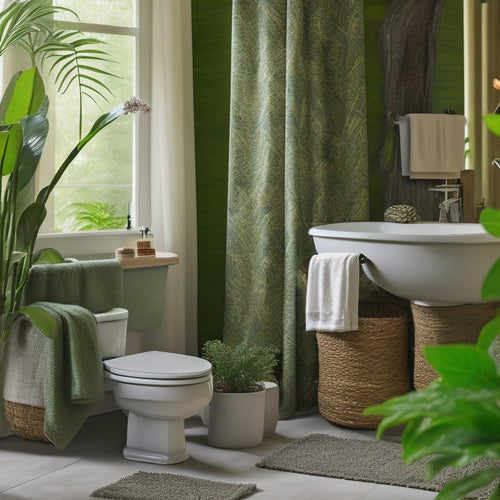
7 Essential Greywater Systems for Water-Wise Homes
Share
You're likely considering incorporating a greywater system into your water-wise home, but with numerous options available, it's crucial to choose the right one. You can opt for a grey water diversion device, which separates greywater from blackwater for irrigation and toilet flushing, or a laundry-to-landscape system, which redirects washing machine wastewater for irrigation. Branched drain greywater systems offer a simple installation process, while grey water treatment units guarantee greywater meets regulations for safe reuse. Irrigation-based greywater systems, greywater filtration solutions, and automatic greywater controllers are also viable options. By exploring these systems, you'll uncover the perfect solution for your water-conserving goals.
Key Takeaways
- Greywater systems reduce potable water consumption, lower water bills, and mitigate wastewater generation, making them essential for water-wise homes.
- There are various greywater system types, including diversion devices, laundry-to-landscape systems, and branched drain greywater systems, each with its benefits and requirements.
- Effective greywater management involves treatment units that remove contaminants, ensuring safe reuse for irrigation and toilet flushing while reducing environmental impact.
- Filtration solutions, such as physical, biological, and hybrid systems, are crucial for removing contaminants and maintaining system efficiency, requiring regular maintenance and inspections.
- Automatic greywater controllers simplify maintenance, optimize water conservation, and ensure system efficiency, making them a vital component of water-wise homes.
Grey Water Diversion Devices
You install grey water diversion devices to separate grey water from blackwater, allowing you to redirect the former for irrigation and flushing toilets. This separation is essential as greywater regulations vary by region, and incorrect handling can lead to fines or system shutdown.
Additionally, incorporating energy-efficient solutions, such as renewable energy solutions, can further reduce your environmental footprint. By redirecting grey water, you can reap system benefits like reduced potable water consumption and lower water bills.
These devices typically consist of valves, pipes, and tanks that redirect grey water from sinks, showers, and washing machines to a separate storage tank. From there, the treated grey water can be used for irrigation, toilet flushing, or other non-potable purposes, giving you more control over your water usage and reducing your environmental footprint.
Laundry-to-Landscape Systems
By separating grey water from blackwater, homeowners can access new opportunities for water conservation. Laundry-to-Environment (L2E) systems are a type of greywater system that redirects wastewater from washing machines to irrigate surroundings. This approach offers several benefits, including reduced water consumption and lower energy bills.
| Laundry Benefits | Environment Enhancement | System Requirements |
|---|---|---|
| Reduced water consumption | Irrigates plants, reducing municipal water usage | 1-2 inches of mulch around irrigation area |
| Lower energy bills | Increases soil moisture, reducing evaporation | Washing machine must be located uphill from irrigation area |
| Prolonged septic system life | Supports healthy plant growth, reducing need for fertilizers | Regular maintenance of irrigation system necessary |
Branched Drain Greywater Systems
You'll find that branched drain greywater systems offer a relatively simple installation process, which translates to reduced labor costs.
With fewer fittings and connections required, you'll also benefit from reduced material costs. By leveraging these advantages, you can create an efficient and cost-effective greywater system that meets your water-wise needs.
Additionally, incorporating renewable energy sources, such as solar energy, can further reduce your carbon footprint and enhance energy independence.
This hybrid approach can optimize energy usage, controlling consumption and minimizing costs and environmental impact.
Simple Installation Process
Frequently, homeowners who opt for branched drain greywater systems report a relatively seamless installation experience. This eco-friendly solution isn't only beneficial for water conservation but also promotes sustainable practices, much like recycling hazardous waste, which can cost between $0.10 to $1.50 per pound hazardous waste disposal.
You can enjoy a hassle-free DIY greywater installation process with this innovative plumbing solution. Branched drain greywater systems are designed to be installed alongside your existing plumbing infrastructure, making it easier to integrate into your home.
Minimal disruption to your daily routine, no need for extensive excavation or digging, quick connection to your existing plumbing system, easy integration with your irrigation system, and flexibility to customize the system to your specific needs.
Reduced Material Costs
With branched drain greywater systems, installation is just the beginning of the cost savings.
You'll also benefit from reduced material costs, making these systems a budget-friendly solution for water-wise homes. By using smaller diameter pipes and fewer fittings, you'll require less material overall, resulting in significant cost savings.
Additionally, branched drain systems often eliminate the need for expensive pumps and tanks, further reducing material costs.
As seen in Renewable Energy Sources for EV Charging, sustainable practices can lead to a reduction in energy waste and carbon emissions.
These cost-effective alternatives allow you to allocate resources to other important aspects of your home, giving you the freedom to focus on what matters most.
Grey Water Treatment Units
How do grey water treatment units fit into the overall greywater system? They play an essential role in ensuring that greywater is treated to meet greywater regulations and can be reused safely.
Treatment units remove contaminants and pollutants, making the water suitable for irrigation and flushing toilets. Additionally, incorporating energy-efficient solutions, such as solar-powered charging solutions, can further reduce the carbon footprint of greywater systems. By leveraging renewable energy sources, these systems can minimize their reliance on traditional power sources.
You'll want to take into account the following when selecting a treatment unit:
- Type of treatment technology (e.g., aerobic, anaerobic, chemical)
- Treatment capacity (gallons per day)
- Maintenance requirements and frequency
- Space requirements and installation constraints
- Environmental benefits, such as reduced water consumption and wastewater generation
Irrigation-Based Greywater Systems
You can design an irrigation-based greywater system to optimize water efficiency in your environment. By reusing greywater for irrigation, you'll reduce your potable water demand, achieving significant water conservation.
This approach also provides environmental benefits by decreasing the amount of wastewater entering sewage systems and recharging groundwater aquifers.
You'll need to take into account factors like soil type, slope, and vegetation when designing your system. Properly sized pipes and distribution networks will guarantee efficient water distribution.
Additionally, you may need to install a surge tank to store excess greywater during peak generation periods.
With careful planning, an irrigation-based greywater system can be an important component of your water-wise home.
Greywater Filtration Solutions
You'll need to contemplate various treatment options for your greywater filtration system, including physical, biological, and chemical methods.
The type of filtering you choose will depend on the level of treatment required and the specific contaminants present in your greywater.
Treatment Options
Implementing a greywater system requires careful consideration of treatment options to guarantee the water is safe for irrigation and other non-potable uses.
You'll need to choose a treatment method that not only meets greywater regulations but also provides ideal environmental benefits.
- Screen and filter systems: remove larger particles and debris from greywater
- Biological treatment systems: use microorganisms to break down organic matter
- Chemical treatment systems: use disinfectants or sanitizers to kill bacteria and viruses
- Greywater wetlands: use natural processes to treat greywater
- Hybrid systems: combine multiple treatment methods for ideal results
Filtering Types
Screening out contaminants is a key step in greywater treatment, and filtering types play an essential role in this process. You'll want to choose a filtering system that effectively removes pollutants and contaminants from your greywater. There are two primary filtering types: physical and biological filtration.
| Filtering Type | Description | Effectiveness |
|---|---|---|
| Physical Filtration | Uses physical barriers to remove contaminants | High for large particles, low for small particles |
| Biological Filtration | Uses microorganisms to break down organic matter | High for organic matter, low for inorganic particles |
| Chemical Filtration | Uses chemicals to remove contaminants | Medium for organic and inorganic particles |
| Mechanical Filtration | Uses mechanical forces to remove contaminants | Medium for large and small particles |
| Hybrid Filtration | Combines multiple filtering types | High for various types of contaminants |
When selecting a filtering type, consider the specific contaminants present in your greywater and the level of treatment required for safe reuse.
System Maintenance
Having selected a suitable filtering type for your greywater system, it's now important to focus on maintaining the system to guarantee it continues to function effectively.
This guarantees system longevity and prevents costly repairs down the line.
To maintain your greywater system, you should:
- Perform routine inspections every 3-6 months to identify potential issues
- Check and clean filters regularly to prevent clogging
- Monitor water flow rates and adjust as necessary
- Inspect pipes and connections for signs of wear or damage
- Keep records of maintenance and repairs for future reference
Automatic Greywater Controllers
Three key components make up a greywater system: the collection, treatment, and dispersal of wastewater.
As you consider implementing a greywater system in your water-wise home, you'll want to guarantee efficient management of these components. This is where automatic greywater controllers come in.
These controllers use automatic sensors to monitor and regulate the flow of greywater, guaranteeing that it's properly treated and dispersed. This not only simplifies system maintenance but also optimizes water conservation.
With an automatic controller, you can rest assured that your greywater system is working efficiently, freeing you to focus on enjoying the benefits of water conservation.
Frequently Asked Questions
Can I Use Greywater for Flushing Toilets and Running Appliances?
You can use greywater for flushing toilets and running appliances, but you'll need proper greywater treatment to guarantee it's safe and sanitary; a well-designed system can provide a reliable supply for toilet flushing and appliance use.
How Often Should I Inspect and Maintain My Greywater System?
You're part of the 30% of homeowners who utilize greywater, reducing potable water usage! To guarantee your system's efficiency, you should inspect and maintain your greywater setup every 3-6 months, checking for clogs, sediment buildup, and proper drainage.
Are Greywater Systems Safe for Households With Septic Systems?
You guarantee safety by complying with greywater regulations, selecting appropriate treatment methods, and regularly inspecting your system to prevent contamination of your septic system, allowing you to enjoy water independence without compromising your household's health.
Can I Install a Greywater System in an Existing Home?
You can install a greywater system in your existing home, but be prepared to manage installation challenges and guarantee compliance with local greywater regulations, which vary by state and municipality, before enjoying the water-saving benefits.
Do Greywater Systems Require Special Permits or Licenses?
When you're ready to take the bull by the horns, you'll find that greywater systems often require special permits or licenses, as local authorities have varying greywater regulations and permit requirements that you'll need to manage.
Related Posts
-

Sustainable Scrubbing: Top Bathroom Solutions for Earth-Conscious Homes
You're taking an important step towards creating a more sustainable home by switching to eco-friendly bathroom cleani...
-

3 Best Solar-Powered Biodegradable Accessories for Your Home
You're taking a significant step towards a more sustainable lifestyle by incorporating solar-powered biodegradable ac...
-

10 Eco-Friendly Air Management Tools for Clean Home Living
You're taking an essential step towards creating a healthier living space by seeking eco-friendly air management tool...


